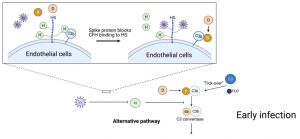A group from Johns Hopkins School of Medicine, Baltimore, USA has reported the importance of aberrant activation of alternative pathway of complement (APC) on COVID-19 severity.
https://pubmed.ncbi.nlm.nih.gov/34289657/
Known complement pathways are three kinds: classical complement pathway, alternative pathway of complement (APC), and lectin pathway. The classical complement pathway needs activation with antibodies, however, in the case of APC, C3 directly adheres on the cell surface, and is activated by factors B and D directly.
It was demonstrated that serum from 58 COVID-19 patients (32 patients with minimal oxygen requirement, 7 on high flow oxygen, 17 requiring mechanical ventilation and 2 deaths) can induce complement-mediated cell death in a functional assay and increase membrane attack complex (C5b-9) deposition on the cell surface. 41.2% COVID-19 patients requiring intubation (n=7/17) were positive in the assay (>20% cell killing) and only 6.3% of COVID-19 patients requiring minimal oxygen support (n=2/32) were positive in the same evaluation. And further, C5 and factor D inhibition effectively mitigated the complement amplification induced by COVID-19 patient serum, and increased serum factor Bb level was associated with disease severity in COVID-19 patients, suggesting that APC dysregulation plays an important role.
It was found that SARS-CoV-2 spike proteins directly block complement factor H from binding to heparin, which may lead to complement dysregulation on the cell surface. That is, early in infection, the SARS-CoV-2 spike protein binds heparan sulfate on the endothelial cell surface and interferes with the inhibitory function of complement factor H (CFH), leading to APC dysregulation. Suppression of CFH binding results in increased cleavage of factor B by factor D and generation of Bb. Factor Bb binds to C3b to form the alternative pathway C3 convertase (C3bBb), leading to the cleavage of C3 and generation of the C5 convertase (C4b2a3b or C3bBb3b). The C5 convertase cleaves C5 to generate C5a and C5b, which complexes with C6-9 to form the membrane attack complex (C5b-9) and kills the cell, leading to excess inflammation. As a conclusion, APC dysregulation due to SARS-CoV-2 contributes to the pathogenesis of COVID-19 and may be a marker of disease severity.

